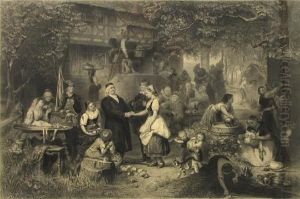Goupil & Cie Paintings
Goupil & Cie was not a single artist but rather a leading art publishing firm based in Paris, France, that played a significant role in the art market of the 19th century. Founded in 1829 by Henri Rittner and Theodore Laurent as Rittner & Goupil, it was later joined by Adolphe Goupil who became a partner in 1831, leading to the firm being renamed Goupil & Cie. The company specialized in the production and distribution of art reproductions, particularly engravings and lithographs, making the works of contemporary and classical artists accessible to a broader audience.
Under the leadership of Adolphe Goupil, the firm expanded its operations internationally, establishing branches in London, Brussels, The Hague, and eventually New York City, becoming one of the first truly global art networks. Goupil & Cie was instrumental in promoting the careers of several important 19th-century artists, including Jean-Léon Gérôme, Rosa Bonheur, and William Bouguereau, among others. By producing high-quality reproductions of their works, Goupil & Cie played a crucial role in popularizing these artists across Europe and America.
The firm also had a significant impact on the art market, innovating in the areas of art reproduction technologies and marketing strategies. Goupil's catalogues, art journals, and photogravures helped to disseminate artistic knowledge and foster an appreciation for fine art among the middle class. However, by the late 19th century, the company faced challenges due to changing tastes and the rise of new forms of art reproduction. Vincent van Gogh, whose uncle, C.M. van Gogh, was a partner in the firm, worked for Goupil & Cie in The Hague, London, and Paris offices before embarking on his career as a painter.
In 1911, Goupil & Cie was taken over and eventually integrated into the Boussod, Valadon & Cie, marking the end of its operations under the Goupil name. Despite this, the legacy of Goupil & Cie lives on through its contributions to the dissemination and popularization of 19th-century art. The firm's records, including stock books and sales catalogs, provide valuable insights into the art market of the time and are used by researchers to trace the provenance and reception of artworks.

